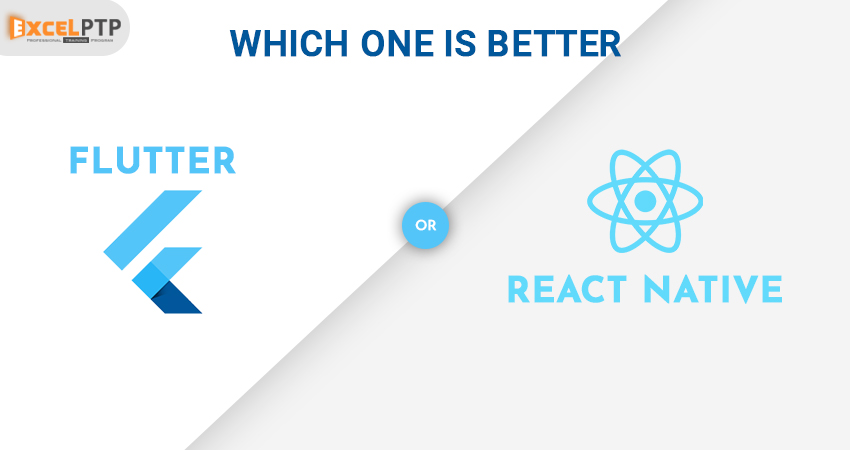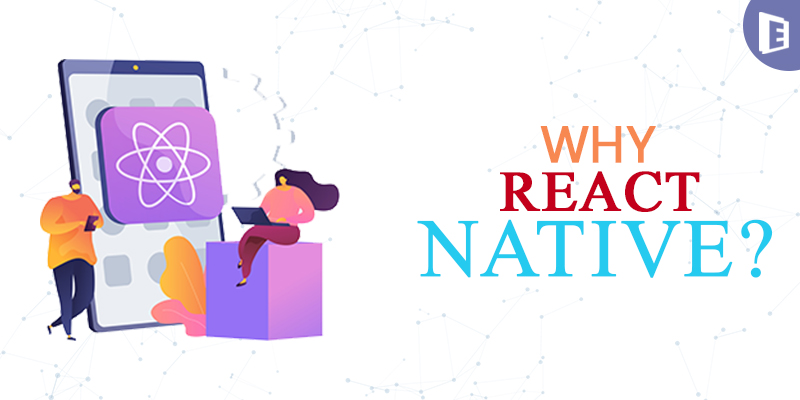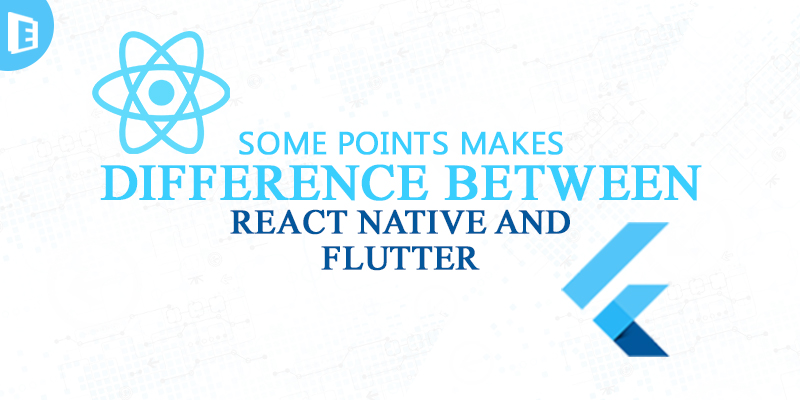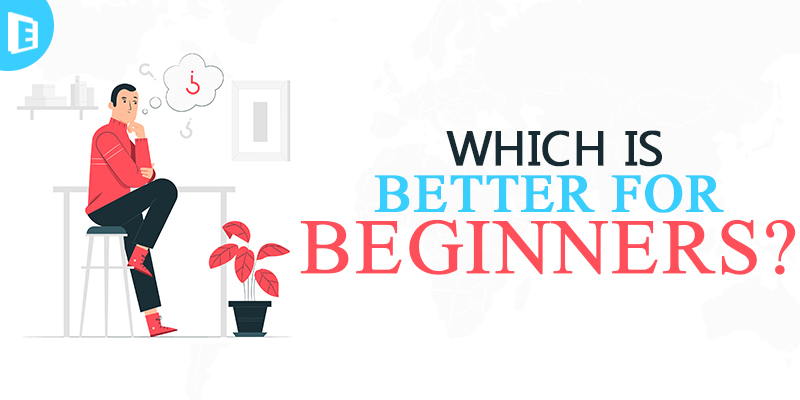flutter vs react native which is better for beginners
Posted By:ExcelPTP
March 24,2021

Flutter vs. React Native: Which Is Better to build a career as Cross platform App developer
In the present day , mobile applications are an essential part of our life. We use them to talk with friends, pay taxes, order pizza, take photos of cats, and much of other stuff. According to statistics, we’re spending longer with our smartphones than ahead of PCs. So today, we’ll consider the history of mobile applications, trying to know how they became the middle of our attention in such a brief period of your time.
Regard it or not, but there was a time when there was neither App Store nor Play Market. The very first mobile was equipped with features like word clock, calculator, calendar, and getting in touch with books. By the way, do you remember Snake? The legendary game that made Nokia extremely popular? At that point , it had been the top of mobile gaming experience.
In 2002, the first BlackBerry smartphone was launched. The device could boast the feature allowing wireless email. This innovation gave an enormous push to mobile application development.
The big change was the announcement of the primary iPhone was an enormous leap towards the evolution of mobile apps. The digital keyboard, multi-touch display, and eventually a functional browser totally revolutionized the way people were using mobile apps.
In simple words, the paradigm that has dominated the entire mobile industry for the past decade has shifted. For users, mobile UX is now more important than all those octa core processors, gigabytes of RAM, and supplementary camera modules.
In today’s ever-evolving digital world, having a practical and powerful mobile app has become essential for businesses of all shapes and sizes. Choosing the proper technology framework is significant for building a successful mobile application, be it iOS or Android.
The purpose of this post is to help you identify the right cross-platform app development framework by comparing important factors like performance, user experience, simple development, convenience, learning curve, as well as many other factors. Both React Native and Flutter are proving to be feasible options for the event of cross-platform mobile applications. However, each of them comes with a variety of benefits also as limitations.
What is React Native?
React Native is an open-source mobile application framework for cross-platform mobile development which is made by Facebook. It was released in March 2015, is used for both mobile as well as web applications. React Native targets iOS, Android, UWP, and Web. React Native empowers the developers by allowing them to use the potential of React Native including different functionalities of all the platforms. This also helps them to integrate all the specified features with none hassles.
It also enables developers to make user interfaces which look exactly like native to every platform. It also allows the developers to ship Android and iOS apps with just one code base.
React Native is written with the mixture of JavaScript or JSX and XML – Esque markup.It is made on top of JavaScript and ReactJS which makes it easier for those developers who want to use such languages.
- It was began as an internal Facebook project in the summer of 2013.
- 1 Preview launched in January 2015 at React.js Conference.
- It got officially launched in March 2015 at F8 Conference.
- Facebook declares React Native as “open for use and available on Github”.
Antiquity of React Native
- Facebook (iOS, Android).
- Instagram (iOS, Android).
- Fb Ads Manager (iOS, Android).
- Wix.com (iOS, Android).
- Tesla (iOS, Android).
- Skype (iOS, Android).
- Bloomberg (iOS, Android).
- Pinterest (iOS, Android).
Popular apps made with React Native
- According to Statista, around 42% of developers admitted to using React Native for cross-platform application development.
- According to a survey of 2020, approx. 11.5% of the developers prefer React Native due to its native libraries and tools.
- The same survey also showed that approx. 58.5% of the community likes using React Native.
Some mind-blowing facts about React Native
- Native rendering: Uses host platform to natively render APIs without the necessity for HTML or CSS markup.
- Performance: Translates the markup of an application to mimic authentic UI elements and yet control high performance.
- Ecosystem: Leverages rich ecosystem and UI libraries to automatically re-render app appearance with each phase change.
- Debugging: Provides accessibility to intelligent debugging tools and blunder reporting.
- Hot-reloading: Allows hot reloading to add advance codes directly into a live application.
Pros of React Native
- User Interface: Native rendering of APIs might not support certain native UI elements, which can make the UI look a touch off.
- Tools and Plugins: Third-party libraries which will be used for better implementation may often end up to be outdated.
- Performance: Doesn’t support parallel threading and multi-processing, leading to slow performance.
- Debugging: Chrome debugger could be inconvenient to edit, inspect codes, and UI elements properly.
Cons of React Native
What is Flutter?
It is an open-source framework which works on the language called Dart which is made by Google. Flutter is additionally a toolkit for software development that targets web platforms, mobile, and desktop. A developer who wants to work on Flutter must learn Dart.Generally, developers who have a background in Java and C++ can relate to Dart more than a JavaScript developer.
It is additionally considered an enhanced UI toolkit which is engaged to develop cross-platform applications with only one codebase. It offers Flutter developers the pliability to create flexible and expressive UI with native performance.
- The first beta version of Flutter was launched at Mobile World Congress in February 2018.
- After a couple of months, at Google I/O, Flutter beta 2 was launched on April 2018.
- Then May 2018, Flutter launched beta 3.
- In June 2018, Flutter Preview 1 was launched.
- Flutter Preview 2 was launched after a couple months in September 2018.
- Dart 2.1 was launched in November 2018.
- Finally, in December 2018, Flutter 1.0 was launched at Google I/O.
- In February 2019, Flutter 1.2 was launched at Mobile World Congress.
- Flutter 1.5 version was launched in May 2019 at Mobile World Congress.
- In July 2019, Flutter 1.7 version was launched.
- After a couple months in September 2019, Flutter 1.9 was launched.
- In December 2019, Flutter 1.12 was launched.
- In May 2020, Flutter 1.17 was announced.
- In August 2020, Flutter came with its 1.20 version.
- On October 1 2020, Flutter launched its latest version Flutter 1.22.
Antiquity of Flutter
- Google Ads app (App Store, Google Play).
- Topline app by Abbey Road Studios (App Store, Google Play).
- Reflectly (App Store, Google Play).
- Hamilton app – the official app for Broadway Musical (App Store, Google Play)
- Xianyu app by Alibaba (App Store, Google Play)
- JD Finance App (App Store)
- Excel Photoscape (By ATPL)
Popular apps made with Flutter
- As per Statista, 39% of people use Flutter for developing cross-platform mobile applications across the world.
- According to survey results, approx 68.8% of people in the developing community love Flutter.
- The same survey also showed that approx 7.2% of the community prefer Flutter for their tools and libraries.
Some astonishing Flutter stats
- Hot-reloading: Stateful Hot Reloading feature reflects changes immediately without losing the appliance state.
- Rich-widgets: Provides rich widgets that follow the rules of Cupertino (iOS) and Material Design (Android).
- Seamless integration: Re-writing code isn’t necessary because it easily integrates with Java for Android and Swift or Objective C for iOS.
- Quick shipping: Offers quick iteration cycles and saves build time as testing is required just for one single codebase.
- Codesharing: Codes are often written and shared across platforms easier and faster, which makes it perfect for MVP development.
Pros of Flutter
- Tools and Plugins: Libraries and tools are extraordinary, yet it’s not as rich as React Native.
- User interface: Vector graphics and animation base have issues in rendering plugins on time.
- Operating platform: Not accordant to develop apps for tvOS, Android Auto, CarPlay, or watchOS.
- Updates: Cannot instantly push patches and updates into applications without passing through the condition release processes.
Cons of Flutter
Below is the explanation of differences based on different fields between React Native and Flutter
Programming Language
React Native: Uses JavaScript which suggests it’s easier for web developers to transition quickly to React Native for mobile app development as against Dart.
Flutter: Apart from the very fact that it’s an entire new language which Dart wasn’t used much, it’s loosely supported Java thanks to conceptual object-oriented support. Also, it’s easy to follow the documentation to urge you to start.
Installation
React Native: Can be installed applying Node Package Manager (NPM) while using macOS you need to have the HomeBrew package manager as well. So for developers having NPM installed the method is basically easy whereas other developers would wish to find out the ins and outs of NPM.
Flutter: Supports binary download straight from GitHub for a specific platform. Also in the bin of macOS after downloading the file needs to be added as a PATH variable.
Setup and Project Configuration
React Native: Not tons is assumed on making the documentation for a developer to urge started. Instead it’s assumed that setup is already done that’s why React Native directly gets to point of making the primary app by writing the command
$ npx react-native init MyTestApp
$ cd MyProject
Flutter: it’s everything little thing documented from IDE Setup, platform specific setup to a CLI tool called flutter doctor.
$ flutter create MyProject
$ cd MyProject
UI Component and Development API
React Native: Relies dully on third-party libraries to access most of the native modules.
Flutter: Rich set of components comprising every native module required which excludes the need of a third-party library. Also, Flutter is full of WIDGETS.
Developer Productivity
React Native: All IDEs support JavaScript so there’ll never be a drag regarding usage consistent with the developer which provides an excellent amount of liberty to each developer involved.
Flutter: Dart isn’t being a daily language in terms of usage, there’s a definite lack of support in many IDEs and text editors.
Community Support
React Native: Being the framework which was released first out of the 2 , it’s imminent to urge an honest amount of support and it surely did since 2015 as it is strongly maintained by the developer on GitHub and from more communities across the planet .
Flutter: Flutter too is on a rapid rise in terms of community support on the other hand again it’ll take some amount of your time for resources to be made available which will ultimately enable developers to solve common issues.
Build & Release Automation Support
React Native: Documentation for automated deployment of apps from any platform isn’t provided so basically you’re on your own to look and deploy it on Play Store or App Store.
Flutter: It’s deployment support through CLI and also a documentation for deployment process with fastlane.
Flutter: Doesn’t contain any official documentation on fixing CI/CD.
Flutter: Features a separate article on CI and testing which you’ll view here. However, you found out CI/CD using Flutter CLI during a very easy manner.
Ultimately, which is Better Flutter or React Native?
In a comparison of React Native vs. Flutter, the last one is best in terms of performance, UI, engineering productivity, and further support, also as market trends. However, React Native is distinctively better when it involves finding software developers. The availability of skilled engineers directly influences the time to plug . For many companies, this is often essential when choosing the simplest technology for an app.
React Native may be a good selection for projects with easy functionality and lots of similar entities, like social media, ecommerce, and customer loyalty apps. If you’re a longtime business with an honest amount of consumers and therefore the mobile app isn’t a primary product, choose React Native, because it helps market apps significantly quicker.
Flutter is great in complicated projects that involve more calculations, CPU load, advanced animations, or integrations with GPS, camera and other device modules. It’s an honest choice for early stage startups to create a beautiful proof-of-concept with minimum functions on a little budget, then scale.
We predict a bright future for both technologies.
Final Words
Choosing the right framework is the only one piece of the puzzle. Developers have a choice to make native apps that are still generally faster and more responsive than hybrid ones, like Flutter or React Native, that in turn require less development time and resources.
More importantly, is that the selection of a partner which will assist you bring your business’s vision to life. At Excelptp we’ve many developers skilled in both React Native and Flutter, also as native app development. We have helped build different apps for companies worldwide which we will assist you achieve your goals also . Contact us so we can help you with bringing your objectives to life.
Apart from above many courses where you can make a bright career get more details by clicking on Available Course and get career related guidelines by visiting Excel PTP office near you.













